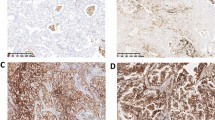Abstract
This study investigated the expression of nucleolin in tissue samples in patients with non-small cell lung cancer (NSCLC). Nucleolin was studied to determine whether it has a prognostic value and if its levels correlate with various clinicopathologic parameters. The relationship between nucleolin and expression of DNA-PKcs was also evaluated. Immunohistochemistry was used for detecting the expression levels of nucleolin and DNA-PKcs in tissues from 225 stage IA to IIIB NSCLC patients who underwent lung surgery. Nucleolin was observed predominantly in the cytoplasm, and some levels were observed in the nucleus. Nucleolin expression was higher in NSCLC tissues than adjacent normal lung tissues. Among 225 NSCLC patients, 117 (52.0 %) had high expression of nucleolin. The expression of nucleolin was significantly associated with pathologic stage (P = 0.013) and T status (P = 0.043). Multivariate analysis revealed that nucleolin, cytoplasmic nucleolin, and nuclear nucleolin expression were independent prognostic factors for both overall survival (OS) (P < 0.001) and disease-free survival (DFS) (P < 0.001). A high level of nuclear nucleolin served as an independent prognostic factor for better survival, while a high level of cytoplasmic nucleolin was closely associated with worse prognosis in NSCLC patients. The expression of nucleolin and cytoplasmic nucleolin positively correlated with DNA-PKcs (P < 0.001). These data suggest that nucleolin could be an effective treatment target and prognostic factor for patients with NSCLC.





Similar content being viewed by others
References
Siegel R, Ma J, Zou Z, Jemal A. Cancer statistics, 2014. CA Cancer J Clin. 2014;64:9–29.
Hanahan D, Weinberg RA. Hallmarks of cancer: the next generation. Cell. 2011;144:646–74.
Bicknell K, Brooks G, Kaiser P, Chen H, Dove BK, Hiscox JA. Nucleolin is regulated both at the level of transcription and translation. Biochem Biophys Res Commun. 2005;332:817–22.
Derenzini M, Sirri V, Trere D, Ochs RL. The quantity of nucleolar proteins nucleolin and protein B23 is related to cell doubling time in human cancer cells. Lab Investig. 1995;73:497–502.
Willimott S, Wagner SD. Post-transcriptional and post-translational regulation of Bcl2. Biochem Soc Trans. 2010;38:1571–5.
Zhang B, Wang H, Jiang B, Liang P, Liu M, Deng G, et al. Nucleolin/C23 is a negative regulator of hydrogen peroxide-induced apoptosis in HUVECs. Cell Stress Chaperones. 2010;15:249–57.
Xu J, Wang K, Zhang X, Qiu Y, Huang D, Li W, et al. HSP70: a promising target for laryngeal carcinoma radiotherapy by inhibiting cleavage and degradation of nucleolin. J Exp Clin Cancer Res. 2010;26:106.
Ginisty H, Sicard H, Roger B, Bouvet P. Structure and functions of nucleolin. J Cell Sci. 1999;112(Pt 6):761–72.
De A, Donahue SL, Tabah A, et al. A novel interaction [corrected] of nucleolin with Rad51. Biochem Biophys Res Commun. 2006;344:206–13.
Goldstein M, Derheimer FA, Tait-Mulder J, Castro NE, Mraz N, Cruise JL, et al. Nucleolin mediates nucleosome disruption critical for DNA double-strand break repair. Proc Natl Acad Sci U S A. 2013;110:16874–9.
Kobayashi J, Fujimoto H, Sato J, Hayashi I, Burma S, Matsuura S, et al. Nucleolin participates in DNA double-strand break-induced damage response through MDC1-dependent pathway. PLoS One. 2012;7:e49245.
Zhao H, Huang Y, Xue C, Chen Y, Hou X, Guo Y, et al. Prognostic significance of the combined score of endothelial expression of nucleolin and CD31 in surgically resected non-small cell lung cancer. PLoS One. 2013;8:e54674.
Qiu W, Zhou F, Zhang Q, Sun X, Shi X, Liang Y, et al. Overexpression of nucleolin and different expression sites both related to the prognosis of gastric cancer. APMIS. 2013;121:919–25.
Zhang J, Tsaprailis G, Bowden GT. Nucleolin stabilizes Bcl-X L messenger RNA in response to UVA irradiation. Cancer Res. 2008;68:1046–54.
Chen J, Guo K, Kastan MB. Interactions of nucleolin and ribosomal protein L26 (RPL26) in translational control of human p53 mRNA. J Biol Chem. 2010;287:16467–76.
Xu JY, Lu S, Xu XY, Hu SL, Li B, Qi RX, et al. Knocking down nucleolin expression enhances the radiosensitivity of non-small cell lung cancer by influencing DNA-PKcs activity. Asian Pac J Cancer Prev. 2015;16:3301–6.
Beskow C, Skikuniene J, Holgersson A, Nilsson B, Lewensohn R, Kanter L, et al. Radioresistant cervical cancer shows upregulation of the NHEJ proteins DNA-PKcs, Ku70 and Ku86. Br J Cancer. 2009;101:816–21.
Hu S, Qu Y, Xu X, Xu Q, Geng J, Xu J. Nuclear survivin and its relationship to DNA damage repair genes in non-small cell lung cancer investigated using tissue array. PLoS One. 2013;8:e74161.
Rosenberg JE, Bambury RM, Van Allen EM, Drabkin HA, Lara Jr PN, Harzstark AL, et al. A phase II trial of AS1411 (a novel nucleolin-targeted DNA aptamer) in metastatic renal cell carcinoma. Investig New Drugs. 2014;32:178–87.
Acknowledgments
We are grateful to Dr. Geng Jing-shu at the Third Affiliated Hospital of Harbin Medical University. Xu Jian-yu was supported by a hospital research startup fund at the Third Affiliated Hospital of Harbin Medical University (JJZ2011-19). Xiang-ying Xu was supported by the Heilongjiang Provincial Science and Technology projects (WB12C101) and Special Fund for Innovative Talent in Science and Technology Research of Harbin (2012RFXXS063).
Author information
Authors and Affiliations
Corresponding authors
Ethics declarations
Conflicts of interest
None.
Rights and permissions
About this article
Cite this article
Xu, Jy., Lu, S., Xu, Xy. et al. Prognostic significance of nuclear or cytoplasmic nucleolin expression in human non-small cell lung cancer and its relationship with DNA-PKcs. Tumor Biol. 37, 10349–10356 (2016). https://doi.org/10.1007/s13277-016-4920-6
Received:
Accepted:
Published:
Issue Date:
DOI: https://doi.org/10.1007/s13277-016-4920-6




